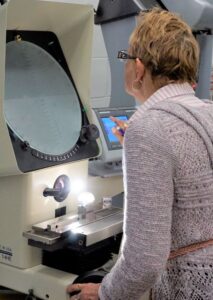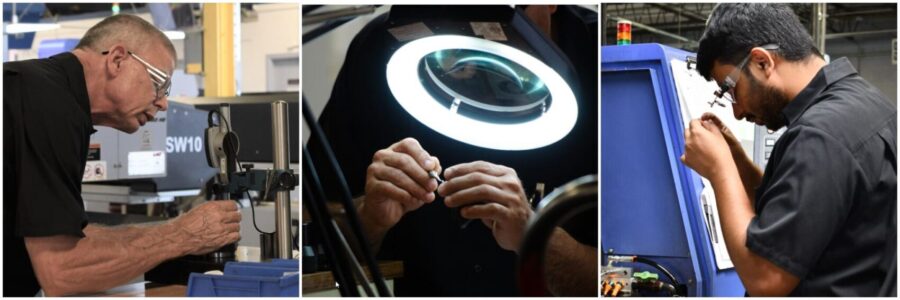The Production Part Approval Process (PPAP) is a valuable tool for establishing confidence in a component supplier’s production processes. The PPAP process was initially specified in the automotive and aerospace industries. Today, it has been integrated into the requirements of some medical and industrial customers.
At Pioneer Service, we get many more requirements for FAI samples and documentation than we do PPAP requirements. However, our Quality Department is familiar and accustomed to meeting, both of these levels of quality documentation, along with a wide variety of customer specific quality reporting. Because the type of precision turning we produce on our CNC Swiss and CNC Turning Center equipment is well suited to complex geometries, tight tolerances and fine surface finishes, we are making components for a variety of highly engineered products on a daily basis.
What exactly is the Production Part Approval Process (PPAP)?
The PPAP process verifies (through various levels of sample and process documentation and submission) that the supplier understands all the part specifications and customer requirements. It also verifies that their production processes are capable of consistently producing parts that meet those requirements during an actual production run at the quoted production rate. In short, can they make approved parts at the rates they quoted (to ensure costs, as well as quality)?
The PPAP process is used for
- New or revised parts.
- Parts produced from new or significantly revised production methods (such as new equipment, addition of new process steps, or changes in outside vendors used in the manufacturing process).
The 5 Levels of PPAP Submission Packages
There are 5 submission levels of PPAPs – requiring increasing levels of documentation and samples as evidence that the supplier can meet the designated requirement. Typically, PPAP levels are requested at the beginning of a new part or revised part sampling and production run, but they can technically be requested at any time. The submission process is fairly time consuming, complex and requires significantly more documentation at all levels of production, which is why it is usually included as a requirement in the quoting process.
- Level 1 – Part Submission Warrant only.
- Level 2 – Part Submission Warrant with product samples and limited supporting data.
- Level 3 – Part Submission Warrant with product samples and complete supporting data.
- Level 4 – Part Submission Warrant and other requirements (details provided by the customer).
- Level 5 – Part Submission Warrant with product samples, complete supporting data available and onsite review of all data and processes at the supplier’s manufacturing facility.
The 18 Elements Required in the 5 levels of PPAPs
- Design Documentation: A copy of the customer part and the supplier production related drawings, a copy of the purchase order and material certificates showing composition.
- Engineering Change Documentation: If the PPAP is being required due to a request for a change/revision to a part, a copy of the Engineering Change Notice (ECN), which must be approved by the customer engineering department, needs to be included.
- Customer Engineering Approval: The supplier must provide evidence of approval by the customer engineering department. This usually comes after samples are submitted for testing by the customer and documentation supplied by the customer when the testing is successful.
- Design Failure Mode and Effects Analysis: Design Failure Mode and Effects Analysis (DFMEA) is a cross-functional activity that examines design risk by exploring the possible failure modes and their effects on the part and their probability to occur. Pioneer Service is not responsible for the design of the custom components that we are machining, so this element of the PPAP is done either by our customer or the design/engineering firm that designed the part for them.
- Process Flow Diagram: The Process Flow Diagram outlines the entire process for manufacturing the part in a visual method (versus text based). The process flow includes incoming material, production, outside processing, testing, packaging and shipping.
- Process Failure Mode and Effects Analysis: Process Failure Mode and Effects Analysis (PFMEA) reviews all the steps in the production process to identify any potential process quality risks and then documents the controls put in place to reduce or eliminate the risks. This document should be updated throughout the production life of the part.
- Control Plan: The Control Plan is an output from the PFMEA. The Control Plan lists all part characteristics and inspection methods required to deliver parts that consistently meet the customer requirements.

- Measurement System Analysis Studies: Measurement System Analysis (MSA) studies will include Gage Repeatability & Reproducibility (GR&R) studies on measurement equipment used during production and quality control checks. Calibration records for all gages and measurement equipment must be included.
- Dimensional Results: A dimensional layout is required to validate the part meets the print specifications. The samples should be randomly selected from a significant production run (usually designated by the customer). Each dimension on the drawing is measured to verify it falls within specification. The results are recorded and included within the PPAP submission.
- Records of Material / Performance Tests: This includes a copy of the Design Verification Plan and Report (DVP&R) which is a summary of every validation test performed on the part. This report lists every test performed on the part, a description of how the test was performed and the results of each test. This would include any test completed by outside finishing suppliers as well (heat treatment, plating, etc.)
- Initial Process Studies: Initial process studies will need to be completed on all the production processes and must include Statistical Process Control (SPC) charts on the critical characteristics of the part. Most importantly, the results should demonstrate that the critical processes are stable, demonstrate normal variation and are running near the intended nominal value.
- Qualified Laboratory Documentation: Qualified laboratory documentation consists of the industry certifications for any lab that was involved in completing validation testing. This may be for an in-house lab or any outside labs contracted for validation or material certification testing.
- Appearance Approval Report: The Appearance Approval Inspection (AAI) may be required when the part affects the customer’s final product appearance (such as the knobs on a lab instrument). This report verifies that the customer has inspected the part and it meets all the required appearance specifications for the design (such as color, surface finish, etc.).

- Sample Production Part: Sample production parts (usually from an initial production run) are sent to the customer for approval and are typically stored at either the customer or supplier’s facility for future reference. A picture of the approved production part is usually included in the PPAP documentation along with documentation regarding the location that the sample parts are being stored.
- Master Samples: Master samples are final samples of the product that are inspected and signed off by the customer. The master sample parts are used to train operators running the equipment. Also, they serve as a benchmark for comparison to standard production parts if any part quality questions arise.
- Checking Aids: A detailed list of “checking aids” used in production which includes all tools and equipment used to inspect, test or measure parts. The list will describe the tool/equipment and have the calibration schedule for each. Checking aids may include variable and attribute gages, calipers, comparators, CMMs, etc.
- Customer Specific Requirements; This element of the submission package is where any special customer requirements are contained. This might be special packaging requirements, special reporting requirements, etc.
- Part Submission Warrant: The Part Submission Warrant form is a summary of the entire PPAP submission. A PSW is required for each of part number unless otherwise stated by the customer.
The PSW includes:
- The reason for submission (new part, design change, annual re-validation, etc.)
- The level of documents submitted to the customer
- Declaration of part conformity to customer requirements
- Any required explanation or comments
- The signature and contact information for the supplier authorized manager
- A section for the customer to indicate disposition of the PPAP
As you can see, the PPAP process is not for the faint hearted. It is a lengthy and complex process. It requires significant collaboration, time and resources for both the customer and the supplier. As mentioned earlier, Pioneer Service gets many more requests for FAI certification on first production orders, however we are prepared to work with any customer’s requirements.
For more information about the PPAP process, Pioneer Service’s quality program, or our CNC Swiss machining and CNC turning capabilities, please contact us today and we will be happy to have our Engineering and Quality team meet with you to discuss this in greater detail.



